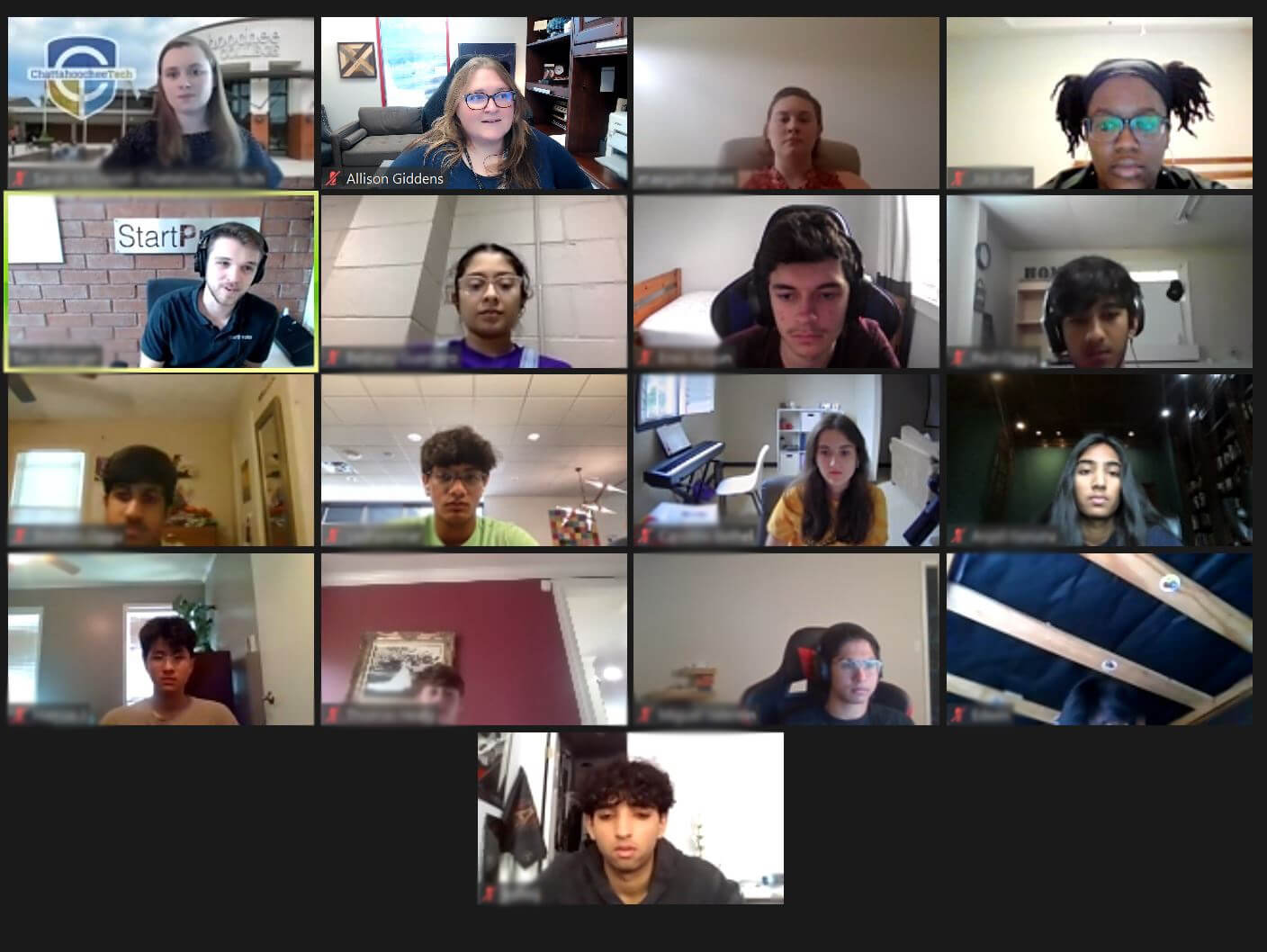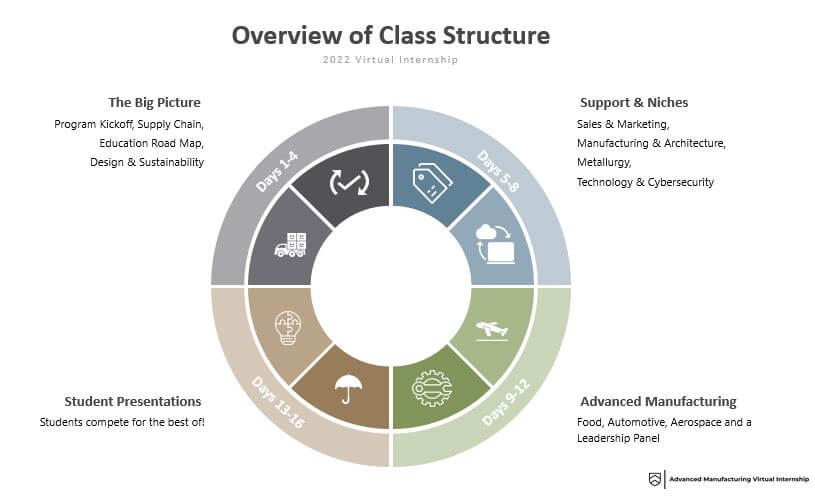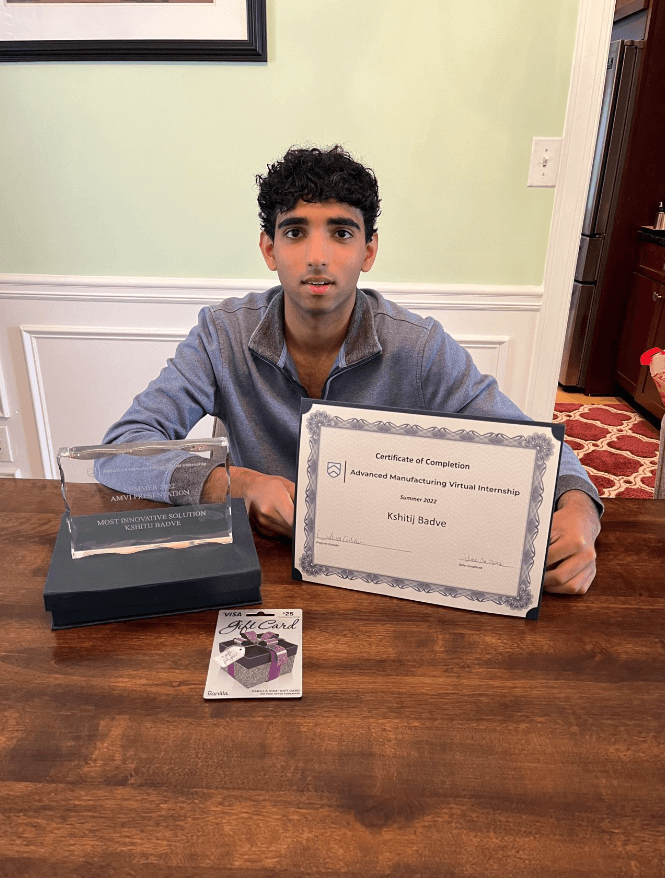
How to Build a Successful Virtual Manufacturing Internship
In the early days of the pandemic, Win-Tech was faced with the decision to either cancel an in-person manufacturing internship with two students or figure out a way to turn the opportunity into a virtual one.
Within a matter of days, we created a 4-week program (for 60-90 minutes a day) that featured ten industry professionals from manufacturing and engineering, and subject matter experts that shared visuals and opened the conversation to talk about their careers and education path – all done via video chat. The program wrapped up with student-led presentations on topics that highlighted a variety of STEM topics.
Over the last three years, the program has evolved and grown, attracting high school juniors and seniors to learn and discover manufacturing opportunities that they didn’t previously know existed: Everything from sustainability in design engineering, to supply chain analysts, and smart factory leads.
Since the Summer of 2020, Win-Tech has hosted four iterations of the Advanced Manufacturing Virtual Internship. In total, the program has benefited more than 50 students from around the world – at no cost to the students.
The program’s initial intent was to fill the need for an internship during a time where many of us thought workarounds like this would be temporary, but the effort has expanded as industry professionals realize that the concept can be duplicated across industries and companies fairly simply, with the support of a team that believes in workforce development.

Students from the Summer 2022 program listen to panelists during a day featuring industry professionals and “Education Road Maps.”
How to Set Up an Advanced Manufacturing Virtual Internship at Your Organization
Step 1: Identify your audience
You may already have a relationship with a local high school, or you may wish to start developing one now. Ideally, the AMVI program was built for rising high school juniors and seniors. Work with your educational contact to identify students who may wish to apply and find a mutually agreed upon time on the calendar.
The AMVI that we run takes place in the summer. We create a simple application using Microsoft Forms, where students can apply for the program. On the application, we include a question that asks what the student hopes to get from the program. We also ask the student to self-assess themselves on science, technology, engineering, and math classes and subjects. We ask them what their interests and hobbies are, so that we can understand the student better.
Step 2: Determine the program layout
The AMVI was held for 60-90 minutes a day, over lunchtime, for 4 weeks, Monday – Thursday.
This may work for your program, or you may wish to shorten or expand it. Some of this may depend on the number of students you will be working with. We have found the “sweet spot” is 12-15 students in the program. Since the program is virtual, that solves many accessibility and transportation challenges.
 The AMVI program layout for Summer 2022.
The AMVI program layout for Summer 2022.
Step 3: Choose your speakers and topics
Sometimes the topics choose the speakers, and sometimes the speakers choose the topics! Make a list of people in your network:
- Who is engaging?
- Who may be willing to offer an hour of their time to speak to students?
- Who is involved in a piece of industry that needs workers, or an up-and-coming field that is new to the conversation in recent years?
- What topics in manufacturing do you believe fly under the radar? What doesn’t get enough press?
It’s important to remember that the students see themselves in the speakers. Create a speakers list of people who look like the students in race, ethnicity, and gender. Offer a representation to students that is authentic to manufacturing.
When thinking of topics, the idea is to expose students to careers that they may otherwise know nothing about.
Step 4: Set expectations
What do you hope students get out of the program? Make that clear from the start.
Determine your expectations of the students’ day-to-day:
- Will you want them to always have their cameras on?
- If they miss a class, can they still “graduate” from the program?
- Do you intend on recording sessions for students to watch if they miss?
Remind the students that under a free program like this, it’s important to respect the presenters’ time, as they are volunteering. Other expectations to set in regards to your speakers:
- Do you want students to connect with speakers on LinkedIn after the sessions?
- Will you ask students to give presentations on a topic of their choosing at the end of the program? Will they need to incorporate concepts they learned along the way?
- Are the presentations judged?
- If so, who will judge? Our AMVI program creates a competition with the presentations, and many of the speakers return to judge the presentations. The speaking
- practice is great for high school students, and judges and fellow students can ask students questions after their presentations.

Kshitij B. is awarded “Most Innovative Solution” for his presentation in the Advanced Manufacturing Virtual Internship.
Step 5: Share your success and lessons learned
Use social media to spread the word about the program! Thank your speakers and volunteers.
Offer to help others create a program just like this. Depending on your virtual internship layout, you could use the program to identify potential in-house interns or find your next rockstar employee.
You can use the program to give back to your local community, and to bring brand awareness to a new generation. Use it to dispel manufacturing myths, celebrate your industry, and provide give-back opportunities to your manufacturing network.
You can’t be what you can’t see. Let’s make sure the next generation sees manufacturing.
Related Content
Learn practical advice for filling the skills gap with modern technology, attracting top talent, and retaining your existing workforce in this roundtable discussion featuring 3 savvy shop owners.
—
Allison Giddens is Co-Owner and President at Win-Tech, a veteran-owned, small business manufacturer specializing in aerospace precision machined parts. Allison has a passion for improving processes, learning new things, and connecting resources to people and people to resources. She’s currently focused on helping manufacturing businesses implement best practices in cybersecurity, developing the workforce, and getting back involved with nonprofits in the post-COVID world, such as the The Dave Krache Foundation, for which she is the Founder & Executive Director.


